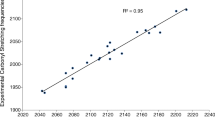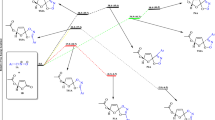Abstract
The N-oxide nitrogen in C-4′ substituted 3-phenyl furoxans occupies a position analogous to C-β in 4-substituted styrenes that have been examined for modes of transmission of substituent effects from the C-4 substituent to C-β. From geometry optimizations through high-level MO theory calculations, it was first ensured that the N-2–C-3 liaison in 3-(4′-substituted)phenyl furoxans retains as much double-bond character as it does in the case of furoxan bearing no substituents and that the para-substituted phenyl and furoxan rings maintain near uniplanarity. The calculations, carried out for such furoxans, chosen to represent a spectrum of effects from electron-donor to electron-acceptor, showed how the change in the 4′-substituent affects electron redistribution within N-oxide group in the way expected: while the residual positive charge at N increases the residual negative charge at O decreases. An increase in the N-oxide bond order (as measured by the Wiberg bond index), together with a small reduction in the N-2–O-6 bond length, was also found. That these effects were not artefacts of the calculation procedure was ensured when the calculations, repeated using a different functional, showed not only inverse dependence of positive N-2 and negative O-6 net charges on N-2–O-6 bond lengths but also confirmatory evidence from N-oxide bond dissociation and second-order perturbation energies. These results are interpreted as demonstrating graded back donation from O to N within the N → O group caused by a combined action of mesomerism and π-polarisation involving the substituent at the para-position of the phenyl group offering a spectrum of effects from electron-releasing to electron-withdrawing.
Graphical abstract
Calculations at the B3LYP/6-31++G** level have shown that back donation from O to N in N → O in 3-(4′-X-phenyl) furoxans increase with a change of X from electron-donor to electron-acceptor.





Similar content being viewed by others
References
Hamer G K, Peat I R and Reynolds W F 1973 Investigations of substituent effects by nuclear magnetic resonance spectroscopy and all-valence electron molecular orbital calculations. 1,4 substituted styrenes I & II Can. J. Chem. 51 897
Ehrenson S, Brownlee R T C and Taft R W 1973 A Generalized Treatment of Substituent Effects in the Benzene Series. A Statistical Analysis by the Dual Substituent Parameter Equation (1) In Progress in Physical Organic A Streitwieser Jr. and R W Taft (Eds.) (New York: Wiley/Interscience) 10 pp. 1-80
Martin G J, Martin M L and Gouesnard J-P 2012 15N-NMR SpectroscopyN-NMR Spectroscopy (Springer-Verlag: Berlin and Heidelberg)
Pasinszki T, Havasi B, Hajgató B and Westwood N P C 2009 Synthesis, spectroscopy and structure of the parent furoxan (HCNO)2 J. Phys. Chem. A 113 170
Godovikova TI, Golova SP, Strelenko YA, Antipin MY, Struchkov YT and Khmel’nitskii LI 1994 Synthesis and properties of unsubstituted furoxan Mendeleev Commun. 1 7
Sillitoe A K and Harding M M 1978 3, 4-Diphenylfurazan N-oxide Acta Cryst. B34 2021
(a) Swain C G and Lupton E C Jr. 1968 Field and resonance components of substituent effects J. Am. Chem. Soc. 90 4328; (b) Hansch C, Leo A, Unger S H, Kim K H, Nikaitani D and Lien E J 1973 Aromatic substituent constants for structure-activity correlations J. Med. Chem. 16 1207. (c) Swain C G, Unger S H, Rosenquist N R and Swain M S 1983 Substituent effects on chemical reactivity. Improved evaluation of field and resonance components J. Am. Chem. Soc. 105 492; (d) Hoefnagel A J, Oosterbeek W and Wepster B M 1984 Substituent effects. 10. Critique of the "improved evaluation of field and resonance effects" proposed by Swain et al J. Org. Chem. 49 1993; (e) Charton M 1984 The validity of the revised F and R electrical effect substituent parameters J. Org. Chem. 49 1997; (f) Taft R W, Abboud J L M and Kamlet M J 1984 Linear solvation energy relationships. 28. An analysis of Swain's solvent "acity" and "basity" scales J. Org. Chem. 49 2001; (g) Swain C G 1984 Substituent and solvent effects on chemical reactivity J. Org. Chem. 49 2005
Bax C M, Katritzky A R and Sutton L E 1958 N-oxides and related compounds. Part VIII. The electric dipole moments of a series of 4-substituted pyridine–boron trichloride complexes J. Chem. Soc. 1254
Acknowledgement
The authors thank the reviewer for constructively suggesting how to confirm the small change observed of the calculated N-oxide bond lengths with a change in C-4′ substituent in the furoxan series is not merely an artefact of the calculation procedure. We have included confirmatory calculations and discussed the results.
Author information
Authors and Affiliations
Corresponding author
Supplementary Information
Rights and permissions
About this article
Cite this article
BALASUBRAHMANYAM, S.N., GANGULY, B., LO, R. et al. Computational evidence for back donation in an N → O group based on modes of transmission of substituent effects in 3-(4′-substituted) phenylfuroxans. J Chem Sci 133, 31 (2021). https://doi.org/10.1007/s12039-021-01885-7
Received:
Revised:
Accepted:
Published:
DOI: https://doi.org/10.1007/s12039-021-01885-7
Keywords
- 3(4′-substituted)phenylfuroxans
- ranges of electron-releasing and electron-attracting substituents
- substituent-dependent N-oxide bond lengths from B3LYP/6-311++G
- inverse residual charge changes at N-2 and O-6
- N-oxide bond dissociation and second-order perturbation energies from B3LYP/6-31++G and BLYP/6-31++G
- back donation from O to N in N–O dative bond




